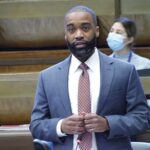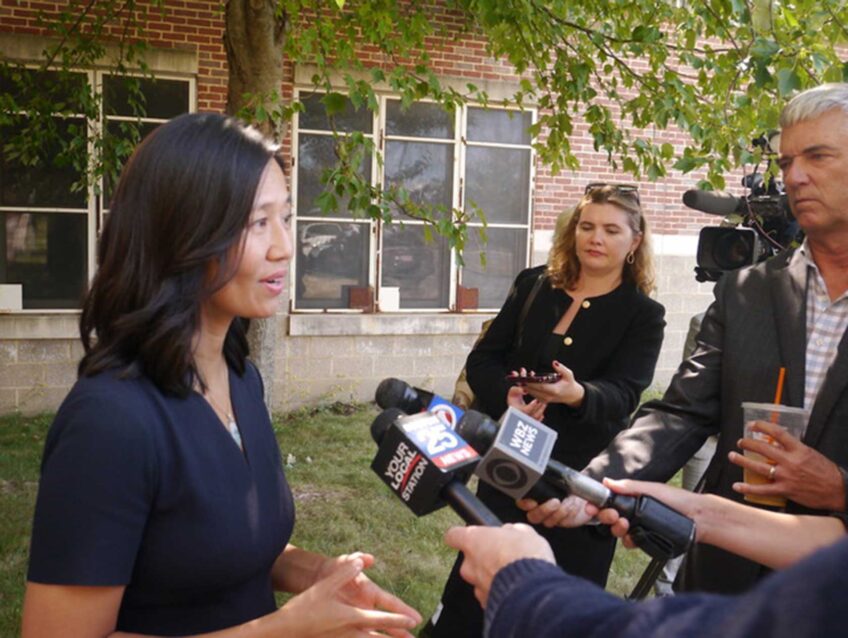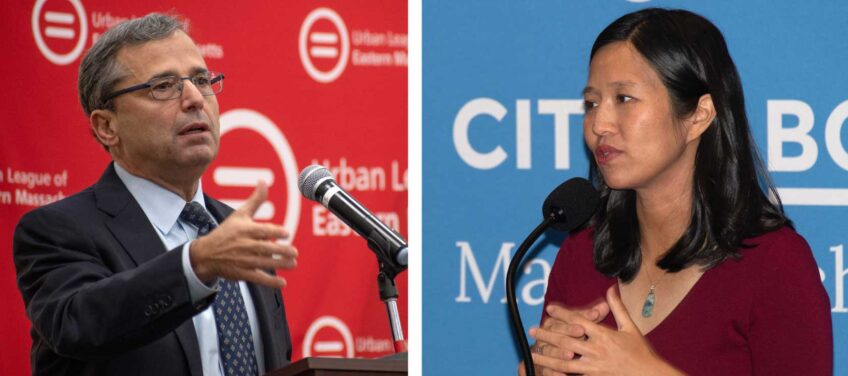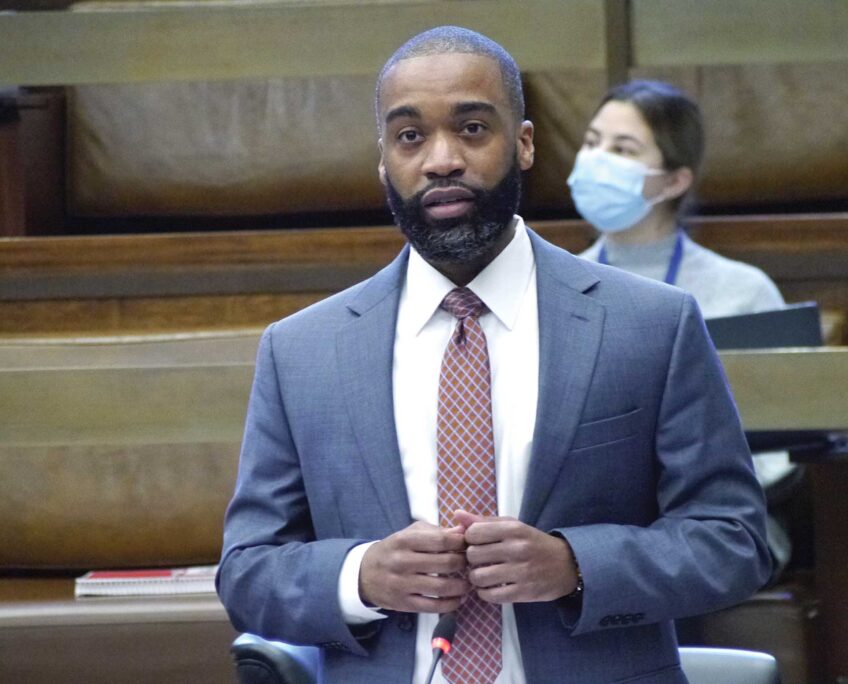Mayor rolls out Brother’s Keeper effort
City to pool resources with businesses and nonprofits
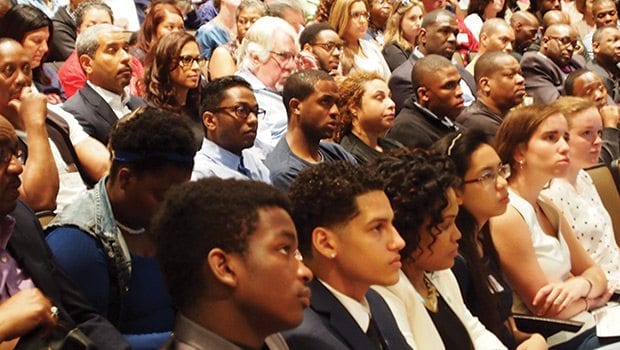
City officials are ready to marshal public, corporate and nonprofit resources in an unprecedented effort to improve outcomes for boys and young men of color in education, in the workforce and in criminal justice, as part of Boston’s version of the national My Brother’s Keeper effort.
Launched last year by President Obama, My Brother’s Keeper is a public-private partnership, funded by $80 million in donations, aimed at improving life outcomes for young men of color. Mayor Martin Walsh released the city’s action plan last week, announcing ways in which city departments will work with nonprofit and business partners to meet the goals outlined by the national program.
Saturday, hundreds filled the auditorium at the Mildred Avenue Community Center for the official launch of Boston’s My Brother’s Keeper effort. City officials, students and community activists took to the stage there to talk about their commitment to making the program a success in Boston.
“Now is the time for action,” Walsh told the gathering. “We’re not going to get equality unless we work for it.”
The effort is aimed at closing the gap between boys and young men of color and their white peers in areas ranging from graduation rates to unemployment.
“Blacks and Latinos are the highest percentage of what’s happening on the negative side of education, criminal justice and employment,” said Felix G. Arroyo, the city’s Chief of Health and Human Services, in an interview with the Banner. “We know we can’t pretend it’s not the situation. We believe it’s entirely possible to change these outcomes. And we have found hundreds of people in the city who agree with us.”

Lauren Jones, policy director for the Office of Health and Human Services meets with John Barros, chief of Economic Development and Felix G. Arroyo, chief of Health and Human Services.
Building on existing efforts
Much of the new plan relies on strengthening existing efforts, like the city’s summer jobs program. Because of the increase in the state’s minimum wage, the city will allocate additional funding to the program. Other parts of the plan are new, like a mentoring program that will recruit people from the city’s business community to help teens with employment readiness.
“It’s a mix of existing and new,” John Barros, the city’s chief of economic development, told the Banner. “With the existing programs, we’re looking at whether we’ve had the impact we want to have on this population. How do we collectively think about something that’s driven by these three goals, really focused with a dashboard that’s measuring outcomes, so that we can make sure we’re having the impact we want to have on this population.
“It’s looking at a number of programs,” Barros continued, “and saying here’s a campaign with a clear vision, a clear set of goals and measuring them to see whether we’re having the kinds or programmatic outcomes we want to see. What are the best practices? What are we learning? It’s a real strategic plan.”
The initiatives spurred by Boston’s My Brother’s Keeper effort will benefit girls and boys alike, Arroyo and Barros said. Youth employment programs, increased resources for vocational and technological programs, mentoring programs, the expansion of the city’s universal pre-kindergarten efforts – are all aimed at boys and girls alike.
“It’s not at the exclusion of black and Latina girls,” Arroyo said. “This is something that will benefit all young people in Boston.”
As an example, Arroyo pointed to curb cuts, which were originally designed to comply with laws mandating accessibility for wheel chairs, but end up being used for everything from strollers to dollies laden with deliveries.
“It turns out that when you do work and create opportunities for those who are most in need and under-served, you’re creating opportunities for everyone,” he said.
Race matters
At the Mildred Avenue Center Saturday, Walsh said he was inspired to join the My Brother’s Keeper effort in part because of an interaction he had while campaigning for mayor. In a Jamaica Plain forum, a woman asked him what he thought about race relations in Boston.
“I said I thought there were tensions, but it wasn’t as bad as it’s been,” Walsh recalled.
The question, and his answer, stayed on Walsh’s mind.
“It bothered me,” he said. “It got under my skin. It made me think about my answer. I thought about young men of color, young women of color. It had a big impact on my campaign.”
Walsh said his campaign pledges to have a cabinet that reflected numerically the majority-people of color racial makeup of the city and to have a majority people of color command staff at the Boston Police Department were informed by his discussions about race on the job.
And the My Brother’s Keeper plan released last week is a step further in addressing issues of racial disparities, Walsh added.
“This document goes beyond saying things,” he said. “It talks about action. We need to make sure we have opportunities for all people. Not just in my cabinet or on the Boston Police command staff. I mean in the whole city.”
Walsh said that as the plan is implemented, he will be monitoring its progress. Key indicators will be updated daily, he said.
“I’ll be looking on the wall every day to make sure we’re doing what we need to be doing.”
Reaction
In the audience were youth workers, clergy, representatives of nonprofit organizations, and city officials, including interim School Superintendent John McDonough. Notably absent was City Councilor Tito Jackson, whose plan for a commission on Black and Latino boys and men the mayor nixed, citing a conflict with the My Brother’s Keeper effort.
Among those who attended, reaction was positive.
“It’s a step in the right direction,” said the Rev. William Dickerson. “If all the parts come together, we’ll have enough in place to move to the next level as a people.”
“I was very impressed with the way they’re putting youth at the forefront of the initiative,” said Jelani Haynes, director of community outreach at Sportsman’s Tennis and Enrichment Center in Dorchester. “I look forward to seeing the progress on it, and getting updates on how the MBK initiative is impacting black lives in the city.”
Reporter Sandra Larson contributed to this story.




